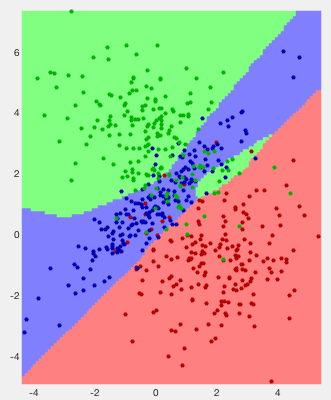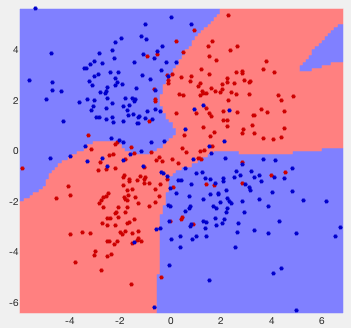Next: Autoencoder Up: ch10 Previous: Perceptron
The back propagation network (BP network or BPN) is a supervised
laerning algorithm that finds a wide variety of applications in
practice. In the most general sense, a BPN can be used as an
associator to learn the relationship between two sets of patterns
represented in vector forms. Specifically in classification,
similar to the perceptron network, the BPN as a classifier is
based on the training set
![${\bf X}=[{\bf x}_1,\cdots,{\bf x}_N]$](img121.svg)


![${\bf Y}=[{\bf y}_1,\cdots,{\bf y}_N]$](img232.svg)



Different from the perceptron in which there is only one level of learning taking place between the output and input layers in terms of the weights, a BPN is a multi-layer (three or more) hierarchical structure composed of the input, hidden, and output layers, in which learning takes place in multilevels between consecutive layers. Consequently, a BPN can be more flexible and powerful than the two-layer perceptron network. In the following, before we consider the general BPN containg multiple hidden layers, we will first derive the back propagation algorithm for the simplest BPN with only one hidden layer in between the input and output layers.
We assume the input, hidden and output layers contain respectively







![${\bf W}^h=[{\bf w}^h_1,\cdots,{\bf w}^h_l]$](img235.svg)
![${\bf W}^o=[{\bf w}^o_1,\cdots,{\bf w}^o_m]$](img236.svg)










Specifically, the training of the BPN is an iteration of the following two-phase process:
A randomly selected sample 


The squared error




We now consider the specific computation taking place in both the forward and backward passes.
![${\bf x}=[x_1,\cdots,x_d]^T$](img44.svg) represented to the input layer to the output
represented to the input layer to the output
![$\hat{\bf y}_n=[y_1,\cdots,y_m]^T$](img241.svg) produced by the output layer:
produced by the output layer:
![${\bf x}=[x_0=1,x_1,\cdots,x_d]^T$](img243.svg) and
and
![${\bf w}_j^h=[w_{j0}^h=b_j^h,w_{j1}^h,\cdots,w_{jd}^h]^T$](img244.svg) are augmented, and
are augmented, and
 is the
activation of the jth hidden layer node. These
is the
activation of the jth hidden layer node. These  equations can be expressed in vector form:
where
equations can be expressed in vector form:
where
![${\bf z}=[z_1,\cdots,z_l]^T$](img247.svg) , and
, and
![${\bf W}^h=[{\bf w}^h_1,\cdots,{\bf w}^h_l]^T$](img248.svg) is an
is an
 matrix.
matrix.
![${\bf z}=[z_0=1,z_1,\cdots,z_l]^T$](img251.svg) and
and
![${\bf w}_i^o=[w_{i0}^o=b_i^o,w_{i1}^o,\cdots,w_{il}^o]^T$](img252.svg) are augmented, and
are augmented, and
 is the
activation of the ith output layer node. These
is the
activation of the ith output layer node. These  equations can be expressed in vector form:
where
equations can be expressed in vector form:
where
![$\hat{\bf y}=[\hat{y}_1,\cdots,y_m]^T$](img255.svg) , and
, and
![${\bf W}^o=[{\bf w}^o_1,\cdots,{\bf w}^o_m]^T$](img256.svg) is an
is an
 matrix.
matrix.
 to the input layer:
to the input layer:
The squared error



 |
 |
![$\displaystyle \frac{1}{2}\vert\vert{\bf y}-\hat{\bf y}\vert\vert^2
=\frac{1}{2}...
...rac{1}{2}\sum_{i=1}^m\left[g\left(\sum_{j=0}^lw_{ij}^{o}z_j\right)-y_i\right]^2$](img262.svg) |
|
 |
![$\displaystyle \frac{1}{2}\sum_{i=1}^m\left[g\left(w_{i0}^o+\sum_{j=1}^l w_{ij}^...
...m_{j=1}^l w_{ij}^o\,
g\left(\sum_{k=0}^d w_{jk}^hx_k\right)\right)-y_i\right]^2$](img263.svg) |
(50) |
Similar to the objective function of the ridge regression considered in a previous section, an additional regularization term can be included in the objective function to encourage small weights to prevent overfitting:
where is the weight decay parameter and
is the weight decay parameter and
 is the
Frobenius norm.
is the
Frobenius norm.
The gradient descent method is used to modify first the
output layer weights and then the hidden layer weights
to iteratively reduce the objective function 
 with respect to the output
layer weights
with respect to the output
layer weights
 by the chain rule:
by the chain rule:
 |
(52) |
 .
.
 to
reduce
to
reduce  by gradient descent method with learning rate
or step size
by gradient descent method with learning rate
or step size  :
:
 |
 |
 |
|
 |
 |
(53) |
 , or in matrix form:
, or in matrix form:
 |
(54) |
![${\bf d}^o=[d_1^o,\cdots,d_m^o]^T$](img277.svg) is the elementwise
(Hadamard) product
is the elementwise
(Hadamard) product
 ,
and
,
and
 is the outer
product of
is the outer
product of  and
and
![${\bf z}=[z_0=1,z_1,\cdots,z_l]$](img281.svg) .
.
 with respect to the hidden
layer weights
with respect to the hidden
layer weights
 by the chain rule:
by the chain rule:
 |
 |
 |
|
 |
 |
||
 |
 |
(55) |
 |
(56) |
![$\displaystyle \left[\begin{array}{l}\delta_1^h\\ \vdots\\ \delta_l^h\end{array}...
...
\left[\begin{array}{c}d_1\\ \vdots\\ d_m\end{array}\right]
={\bf W}^o{\bf d}^o$](img288.svg) |
(57) |
 is an
is an  matrix, the same as that
defined above but with the first column of
matrix, the same as that
defined above but with the first column of  's removed.
's removed.
 to
reduce
to
reduce  by gradient descent method:
by gradient descent method:
 |
 |
 |
|
 |
 |
(58) |
 |
(59) |
 is the elementwise product of vector
is the elementwise product of vector
 and
and
 ,
and
,
and
 is the
outer product of vectors
is the
outer product of vectors  and
and  .
.
In summary, here are the steps in each iteration:
![$[x_1,\cdots,x_d]^T$](img301.svg) ,
construct
,
construct  dimensional vector
dimensional vector
![${\bf x}=[1,x_1,\cdots,x_d]^T$](img302.svg) ;
;
 ,
and construct
,
and construct  dimensional vector
dimensional vector
![${\bf z} \leftarrow [1,{\bf z}]$](img305.svg) ;
;

 ;
;
 ;
;
 , where
, where
 is the same as
is the same as  but with
its first column removed.
but with
its first column removed.
 ;
;
 is
acceptably small for all of the training patterns. Otherwise
repeat the above with another pattern in the training set.
is
acceptably small for all of the training patterns. Otherwise
repeat the above with another pattern in the training set.
The Matlab code for the essential part of the BPN algorithm is
listed below. Array 










function [Wh, Wo, g]=backPropagate(X,Y)
syms x
g=1/(1+exp(-x)); % Sigmoid activation function
dg=diff(g); % its derivative function
g=matlabFunction(g);
dg=matlabFunction(dg);
[d,N]=size(X); % number of inputs and number of samples
X=[ones(1,N); X]; % augment X by adding a row of x0=1
Wh=1-2*rand(L,d+1); % Initialize hidden layer weights
Wo=1-2*rand(M,L+1); % Initialize output layer weights
er=inf;
while er > tol
I=randperm(N); % random permutation of samples
er=0;
for n=1:N % for all N samples for an epoch
x=X(:,I(n)); % pick a training sample
ah=Wh*x; % activation of hidden layer
z=[1; g(ah)]; % augment z by adding z0=1
ao=Wo*z; % activation to output layer
yhat=g(ao); % output of output layer
delta=Y(:,I(n))-yhat % delta error
er=er+norm(delta)/N % test error
do=delta.*dg(ao); % Find d of output layer
Wo=Wo+eta*do*z'; % update weights for output layer
dh=(Wo(:,2:L+1)'*do).*dg(ah); % delta of hidden layer
Wh=Wh+eta*dh*x'; % update weights for hidden layer
end
end
end
The training process of BP network can also be considered as a
data modeling
problem to
fit the given data

 |
(60) |
 and
and  that minimize the difference
that minimize the difference
 between
the desired and the actual outputs. The Levenberg-Marquardt algorithm
discussed previously can be used to obtain the parameters, such as
Matlab function
trainlm.
between
the desired and the actual outputs. The Levenberg-Marquardt algorithm
discussed previously can be used to obtain the parameters, such as
Matlab function
trainlm.
The three-layer BPN containing a single hidden layer discussed
above can be easily generalized to a multilayer BPN containing
any number of hidden layers (e.g., for a deep learning network)
by simply repeating steps 6 and 7 for the single hidden layer in
the algorithm list above. We assume in addition to the input layer,
there are in total 

 |
(61) |
 is the activation
of all nodes in the lth layer,
is the activation
of all nodes in the lth layer,
 is the input to the lth
layer, output from the (l-1)th layer (
is the input to the lth
layer, output from the (l-1)th layer (
 ), and
), and
 |
(62) |
 |
(63) |
The matlab code segment below is for the BP network of multiple
hidden layers, in which 


W={1-2*rand(m(1),d+1)}; % initial weights for first layer
for l=2:L
W{l}=1-2*rand(m(l),m(l-1)+1); % initial weights for all other layers
end
er=inf;
while er > tol
I=randperm(N); % random permutation of samples
er=0;
for n=1:N % N samples for an epoch
z={1;X(:,I(n))}; % pick a training sample
a={W{1}*z{1}}; % activation of first layer
for l=2:L % the forward pass
z{l}=[1;g(a{l-1})]; % input to the lth layer
a{l}=W{l}*z{l}; % activation of the lth layer
end
yhat=g(a{L}); % actual output of last layer
delta=Y(:,I(n))-yhat; % delta error
er=er+norm(delta)/N; % test error
d{L}=delta.*dg(a{L}); % d for output layer
W{L}=W{L}+eta*d{L}*z{L}'; % upddate weights for output layer
for l=L-1:-1:1 % the backward pass
d{l}=(W{l+1}(:,2:end)'*d{l+1}).*dg(a{l}); % d for hidden layers
W{l}=W{l}+eta*d{l}*z{l}'; % upddate weights for hidden layers
end
end
end
Example 1: The classification results of two previously used 2-D
data sets are shown below. The error rates are respectively 

![$\displaystyle \left[ \begin{array}{rrr}
185 & 14 & 1 \\ 5 & 181 & 14 \\ 11 & 33...
...
\;\;\;\;\;\;\;
\left[ \begin{array}{rr}176 & 24 \\ 22 & 178 \end{array}\right]$](img335.svg) |
(64) |


Example 2:
The back propagation network applied to the classification of the
dataset of handwritten digits from 0 to 9 used previously. Out of
the 


![$\displaystyle \left[ \begin{array}{rrrrrrrrrr}
113 & 0 & 0 & 0 & 0 & 0 & 0 & 1 ...
... & 2 & 97 & 5 \\
0 & 2 & 0 & 0 & 4 & 0 & 0 & 0 & 0 &102 \\
\end{array}\right]$](img339.svg) |
(65) |
Hierarchical structure and two pathways of the visual cortex